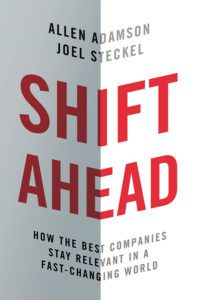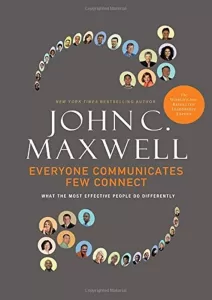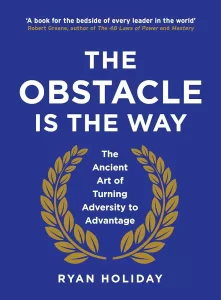Book Review: “Shift Ahead”
Book: Shift Ahead by Allen Adamson and Joel Steckel
Reviewer: Bobby Powers
My Thoughts: 8 of 10
Shift Ahead contains more practical case studies than any book I've ever read. Every chapter is structured around real examples from real companies who faced real business challenges. Adamson and Steckel share stories from Domino's, Xerox, P&G, Barnes & Noble, Kodak, and dozens of other companies to explain when and how to shift corporate strategy amidst continuous global change. Faced with rapid technological advancement, offshoring/outsourcing, and the rise of big data, it's imperative for business strategists to understand the principles from this book.
What I Learned from the Book
It's surprisingly easy for successful businesses to lose their edge. Past success often prevents future success because companies leaders become too attached to the comfort of reliable revenue streams and doing what they've always done. Companies are far more likely to die from stagnancy than from taking risks. The key to success is identifying triggers for when your business needs to change, then focusing on your customers to tell you how you should change.
Selected Quotes and Ideas from the Book
Staying Relevant in a Changing World
- "Businesses must continually ensure that they are relevant to their customers if they want to stay in business. A central premise of this book is that to remain relevant, businesses must indisputably know why they matter to their customers."
- "Consumers don't just want brands to be different and relevant, but to keep being different and relevant...Successful brands recognize this and know it's not a place, it's a direction. The must constantly evolve, not stand still." -John Gerzema
- "In a world that is changing faster and more furiously than ever, the ability to shift ahead, while not losing focus on who you are, is critical."
- "I remember hearing about a project that Time Warner was looking at in 1993 called Pathfinder. It was basically the Internet before its time. There was another project in 1993 called the Orlando TV Project, which was like Netflix. The people who had these ideas were at the pinnacles of their careers and, as a result, they were afraid to move forward. They didn't want to take a risk. They killed off their own innovations because they were not being compensated for these types of initiatives. It's a scary lesson to think about. There's not a day that goes by that there isn't some crazy crisis that forces you to have to rethink how you're operating. The world is changing at a rapid pace and you have to be good at being adaptive all the time." -Maryam Banikarim
One-Minute Case Study #1 - Domino's
- In 2009, the executives at Domino's decided they needed to shift their business model. Profits had been declining for years and consumers maligned their product.
- Domino's hadn't been paying enough attention to their customers. The company was focusing on delivery speed, whereas their competitors had listened to consumers and prioritized taste.
- "While Domino's was working on making its thirty-minute promise efficient (and safe for deliverers), competitors were improving the taste of their products. Just because a firm exceeds expectations on one important customer attribute does not allow it to fall too far behind competitors on other important attributes."
- "Domino's readjusted its company culture to increase focus on the customer. It required that every employee, from the CEO down, master the skill of making the pizza and do it in-store...[T]he company did the unthinkable. It dumped its marketing campaign, which was based on speedy delivery, and shot a series of commercials that focused on taste."
- You may remember the Domino's commercials during this period of time because they explicitly called out the fact that their pizzas tasted bad and they were making a shift to focus on creating better-tasting pizza.
- "The turnaround efforts were a success, and Domino's business today is very good. So good, in fact, that in the last seven years the company had outperformed Amazon, Apple, Facebook, and Google, with its stock going from $9 a share to over $180 a share in early 2017."
- The Lesson: Be honest with yourself and your customers about what you need to change in order to be competitive. Too many companies hide behind illusions of their own success by focusing on data that paints them in a positive light. To avoid self-delusion, trust your customers and what they're telling you about your product.
One-Minute Case Study #2 - Kodak
- Kodak fell from prominence after the rise of digital cameras rendered Kodak's technology obsolete.
- Most consumers think Kodak completely missed the boat by failing to develop digital camera technology. That narrative is false. Kodak actually developed the first digital camera back in 1975! They just failed to invest in digital camera technology until it was too late.
- "I want to make it very clear that we knew digital was coming. There was a fork in the road and they took the wrong fork. We knew we had to replace film, but the problem with film at the time was that the earnings from film were probably 110 percent of the corporate earnings. And that was not a slip of the tongue. The explanation from the company was, 'This is what we do. We have no choice but to be here.'" -Jim Patton, who served as an executive at Kodak for 30+ years
- "That the company clearly recognized that digital imaging and all that went with it represented the next wave in the industry was not the issue. The mother ship did not want to jettison the current business to go full throttle into the new business...The company didn't have the mindset that would allow it to accept that film, paper, and chemicals would go away, and that if the company didn't jump on digital it would be obsolete in ten years. Like many companies in similar situations, they didn't have what it took to be able to 'go big or go home.'"
- The Lesson: When your cash cow is producing every dollar of your profits, it takes a lot of guts to invest in something new that will kill your cash cow. But if you fail to kill it, someone else will. It's better to cannibalize your own profits than it is to let someone else steal them.
Tips for Making the Shift
- Sometimes a drastic shift is the only way to stay viable as a business: "It's not a matter of making small, incremental changes to where you want to go."
- "If you don't make significant shifts at some point, you will find that the only way to keep sales going strong is to adjust the price. If price becomes too important a competitive weapon, it's likely that your brand's point of relevant differentiation is diminishing in the minds of consumers."
- "No matter how successful your business is, remember, it's always day one." -Jeff Bezos
- "When you're trying to ensure your message is always relevant, what you're looking for is the intersection of what is true about yourself, your culture or some purpose or belief system you have, and what is important to your audience. Then you express it through a prism of what is significant to our time. Success is predicated on finding a way to communicate what's special and different about you and meaningful for your target audience in the context of the cultural phenomenon of our time." -Charlie Wrench
Think you’d like this book?
Other books you may enjoy:
Business Adventures by John Brooks
Good to Great by Jim Collins
The Innovator's Dilemma by Clayton Christensen
Other notable books by the author(s):
The Edge: 50 Tips from Brands that Lead by Allen Adamson
BrandSimple: How the Best Brands Keep It Simple and Succeed by Allen Adamson
BrandDigital: Simple Ways Top Brands Succeed in the Digital World by Allen Adamson







